
The gunfight at the O.K. Corral pitted lawmen against members of a loosely organized group of cattle rustlers and horse thieves called the Cowboys on October 26, 1881. While lasting less than a minute, the gunfight has been the subject of books and films into the 21st century. Taking place in the town of Tombstone in Arizona Territory, the battle has become one archetype of the American Old West. The gunfight was the result of a long-simmering feud between five outlaws and four representatives of the law, including three brothers. The trigger for the event was the local marshal's decision to enforce a city ordinance that prohibited the carrying of weapons into town. To enforce that ordinance, the lawmen would have to disarm the Cowboys.

The Johnson County War, also known as the War on Powder River and the Wyoming Range War, was a range war in Johnson County, Wyoming from 1889 to 1893. The conflict began when cattle companies started ruthlessly persecuting alleged rustlers in the area, many of whom were settlers who competed with them for livestock, land and water rights. As violence swelled between the large established ranchers and the smaller settlers in the state, it culminated in the Powder River Country, when the ranchers hired gunmen, who invaded the county. The gunmen's initial incursion in the territory alerted the small farmers and ranchers, as well as the state lawmen, and they formed a posse of 200 men that led to a grueling standoff which ended when the United States Cavalry on the orders of President Benjamin Harrison relieved the two forces, although further fighting persisted.
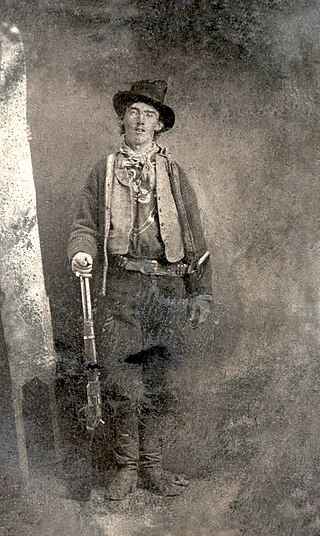
The Lincoln County War was an Old West conflict between rival factions which began in 1878 in Lincoln County, New Mexico Territory, the predecessor of the state of New Mexico, and continued until 1881. The feud became famous because of the participation of William H. Bonney. Other notable participants included Sheriff William J. Brady, cattle rancher John Chisum, lawyer and businessmen Alexander McSween, James Dolan and Lawrence Murphy.
George Scarborough was a cowboy and lawman who lived during the time of the Wild West. He is best known for having killed outlaw John Selman, killer of John Wesley Hardin, and for his partnership with lawman Jeff Milton, with the pair bringing down several outlaws during their time together.
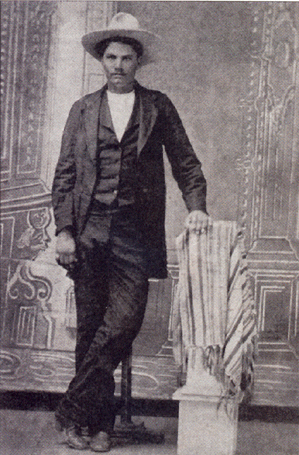
John Wesley Hardin was an American Old West outlaw, gunfighter, and controversial folk icon. Hardin often got into trouble with the law from an early age. He killed his first man at the age of 15, claiming he did so in self-defense.

Gunfighters, also called gunslingers or in the late 19th and early 20th century gunmen, were individuals in the American Old West who gained a reputation of being dangerous with a gun and participated in shootouts. Today, the term "gunslinger" is more or less used to denote someone who is quick on the draw with a handgun, but this can also refer to those armed with rifles and shotguns. The gunfighter is also one of the most popular characters in the Western genre and has appeared in associated films, television shows, video games, and literature.
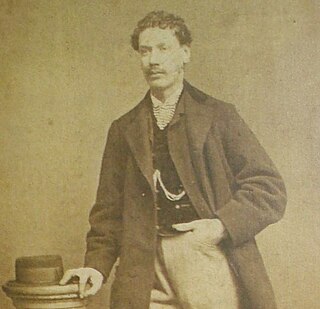
William Brocius, better known as Curly Bill Brocius, was an American gunslinger, rustler and an outlaw Cowboy in the Cochise County area of the Arizona Territory during the late 1870s and early 1880s. His name is likely an alias or nickname, and some evidence links him to another outlaw named William "Curly Bill" Bresnaham, who was convicted of an 1878 attempted robbery and murder in El Paso, Texas.

Joseph Isaac Clanton was a member of a loose association of outlaws known as The Cowboys who clashed with lawmen Wyatt, Virgil and Morgan Earp as well as Doc Holliday. On October 26, 1881, Clanton was present at the gunfight at the O.K. Corral in the boomtown of Tombstone, Arizona Territory, but was unarmed and ran from the gunfight, in which his 19-year-old brother Billy was killed.

Timothy Isaiah Courtright, also known as "Longhair Jim" or "Big Jim" Courtright, was an American Deputy Sheriff in Fort Worth, Texas from 1876 to 1879. In 1887, he was killed in a shootout with gambler and gunfighter Luke Short. Before his death, people feared Courtright's reputation as a gunman, and he reduced Ft. Worth's murder rate by more than half, while reportedly extracting protection money from town business owners.
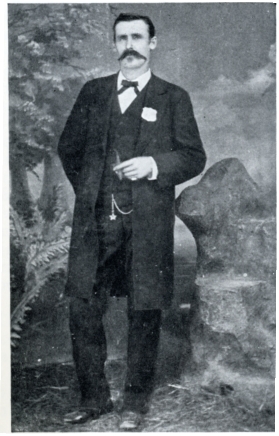
Dallas Stoudenmire was an American Old West gunfighter and lawman who gained fame for a brief gunfight that was later dubbed the "Four Dead in Five Seconds Gunfight." Stoudenmire had a deadly reputation in his day and was involved in several gunfights.
Gustav Krempkau was an El Paso County constable in the late 19th century in El Paso, Texas, during the climax of the "Wild West" era. He died in the Four Dead in Five Seconds Gunfight, which was overshadowed by the events of a few months later at the O.K. Corral. Little is known of his early life, but he is believed to have been about 25 years old when he was killed.

Frank M. Canton was an American Old West fugitive who had a career as a deputy U.S. marshal under an assumed name. Although an ex-sheriff stock detective in Wyoming, Canton and his associates were accused of operating more by assassination than the law. Extrajudicial measures such as the lynching of Ellen Watson inflamed public opinion against the long-established big ranchers Canton worked for, and to re-establish control over grazing they funded an all-out assault on those small operators considered to be rustlers. Canton directed Frank Wolcott's imported gunmen in their planned vigilante campaign, known as the Johnson County War, which was quickly ended by a local posse. Finding himself a marked man in Wyoming, Canton considered it opportune to leave the state. He spent most of the rest of his working life in law enforcement for the court of hanging judge Isaac C. Parker.

Commodore Perry Owens was an American lawman and gunfighter of the Old West. One of his many exploits was the Owens-Blevins Shootout in Arizona Territory during the Pleasant Valley War.

John Henry Selman was sometimes identified as an outlaw and sometimes a working lawman of the Old West. He is best known as the man who fatally shot John Wesley Hardin in the Acme Saloon in El Paso, Texas, on August 19, 1895.
George Washington Campbell was born in Greenup County Kentucky and was the youngest of five children. He moved to Texas in 1875 and by the end of 1876 he was appointed deputy sheriff of Clay County Texas. In November 1880 Campbell moved to El Paso, Texas, where he was named town marshal on December 1, 1880. He served from late 1880 until January 1881, when he was replaced by a new town marshal, Ed Copeland. Campbell was the last person killed by Dallas Stoudenmire in what would later be dubbed Four Dead in Five Seconds Gunfight that took place on April 14, 1881.

Tom McLaury was an American outlaw. He and his brother Frank owned a ranch outside Tombstone, Arizona, Arizona Territory during the 1880s. He was a member of a gang of outlaws and cattle rustlers called the Cowboys that had ongoing conflicts with lawmen Wyatt, Virgil, and Morgan Earp. The McLaury brothers repeatedly threatened the Earps because they interfered with the Cowboys' illegal activities. On October 26, 1881, Tom and Frank were both killed in the Gunfight at the O.K. Corral in Tombstone, Arizona Territory. The Tombstone shootout was his only gunfight.

William Harrison Clanton was an outlaw Cowboy in Cochise County, Arizona Territory. He, along with his father Newman Clanton and brother Ike Clanton, worked a ranch near the boomtown of Tombstone, Arizona Territory and stole livestock from Mexico and later U.S. ranchers.
Dan Tucker, better known as "Dangerous Dan" Tucker,, is a little-known Canadian-American lawman and gunfighter of the Old West.
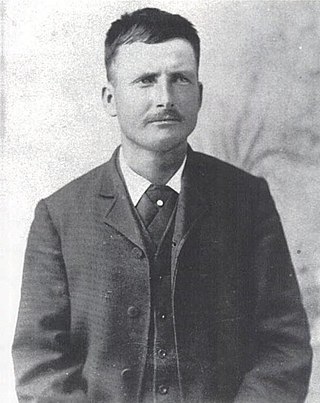
Dan Bogan was an American gunfighter and outlaw of the American Old West, is described as one of the most underrated gunmen of the 19th century west in the book "Deadly Dozen", by author Robert K. DeArment.
Founded as El Paso del Norte by Spanish Franciscan friars at an important mountain pass, the area became a small agricultural producer though most settlement was south of the river where modern Mexico lies. The city was considered part of New Mexico under Spanish Conquerors and was tied economically to Santa Fe, New Mexico and the Chihuahuan mining districts of San Felipe El Real and San José del Parral.















